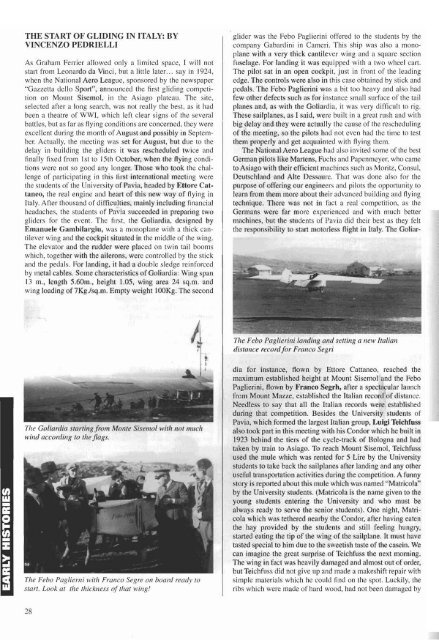VGC News/Newsletters - Lakes Gliding Club
VGC News/Newsletters - Lakes Gliding Club
VGC News/Newsletters - Lakes Gliding Club
You also want an ePaper? Increase the reach of your titles
YUMPU automatically turns print PDFs into web optimized ePapers that Google loves.
THE START OF GLIDING IN ITALY: BY<br />
VINCENZO PEDRIELLI<br />
As Graham Ferrier allowed only a limited space, I will not<br />
start from Leonardo da V~nci, but a little later. .. say in 1924,<br />
when the Nationall Aero League, sponsored by the newspaper<br />
"Gazzetta dello Sport", announced the first gliding competition<br />
on Mount Sisemol, in the Asiago plateau. The site,<br />
selected after a long search, was not really the best, as it had<br />
been a theatre of WWI, which left clear signs of the several<br />
battles, but as far as flying conditions are concerned, they were<br />
excellent during the month of August and possibly in September.<br />
Actually, the meeting was set for August, but due to the<br />
delay in building the gliders it was rescheduled twice and<br />
finally fixed from 1st to 15th October, when the flying conditions<br />
were not so good any longer. Those who took the challenge<br />
of participating in this first international meeting were<br />
the students of the University of Pavia, headed by Ettore Cattaneo,<br />
the real engine and heart of this new way of flying in<br />
Italy. After thousand of difficulties, mainly including financial<br />
headaches, the students of Pavia succeeded ill preparing two<br />
gliders for the event. The first, the Goliardia, designed by<br />
Emanuele GambiIargiu, was a monoplane with a thick cantilever<br />
wing and the cockpit situated in the middle of the wing.<br />
The elevator and the rudder were placed on twin tail booms<br />
which, together with theai erons, were controlled by the stick<br />
and the pedals. For landing, it had a double sledge reinforced<br />
by metal cables. Some characteristics ofGoliardia: Wing span<br />
13 m., length 5.60m., height 1.05, wing area 24 sq.m. and<br />
wing loading of 7Kg.lsQ.m. Empty weight LOOKg. The second<br />
glider was the Febo Paglierini offered to the students by the<br />
company Gabardini in Cameri. This ship was also a monoplane<br />
with a very thick cantilever wing and a square section<br />
fuselage. For landing it was equipped with a two wheel cart.<br />
The pilot sat in an open cockpit, just in front of the leading<br />
edge. The controls were also in this case obtained by stick and<br />
pedals. The Febo Paglierini was a bit too heavy and also had<br />
few other defects such as for instance small surface of the tail<br />
planes and, as with the Goliardia, it was very difficult to rig.<br />
These sailplanes, as I said, were built in a great rush and with<br />
big delay and they were actually the cause of the rescheduling<br />
of the meeting, so the pilots had not even had the time to test<br />
t,hem properly and get acquainted with flying them.<br />
The National Aero League had also invited some of the best<br />
Gennan pilots like Martens, Fuchs and Papenmeyer, who came<br />
to Asiago with their efficient machines such as Moritz, Consul,<br />
Deutschland and Alte Dessaure. That was done also for the<br />
purpose of offering our engineers and pilots the opportunity to<br />
learn from them more about their advanced building and flying<br />
technique. There was not in fact a real competition, as the<br />
Germans were far more experienced and with much better<br />
machines, but tile students of Pavia did their best as they felt<br />
the responsibility to start motorless flight in Italy. The Goliar-<br />
The Febo Paglierini landing and setting a new Italian<br />
diswnce recordfor Franco Segri<br />
The Goliardia starting from Monte Sisemol with not much<br />
wind according to the flags.<br />
The Febo Pagliemi with Franco Segre on board ready to<br />
start. Look at the thickness ofthat wing!<br />
dia for instance, flown by Ettore Cattaneo, reached the<br />
maximum established height at Mount Sisemol and the Febo<br />
Paglierini, flown by Franco Segrh, after a spectacular launch<br />
from Mount Mazze, established the Italiall record of distance.<br />
Needless to say that all the Italian records were established<br />
during that competit,ion. Besides the Univers'ity students of<br />
Pavia, which formed the Largest Italian group, Luigi Teichfuss<br />
also took part in this meeting with his Condor which he built in<br />
1923 behind the tiers of the cycfe-track of Bologna and had<br />
taken by train to Asiago. To reach Mount Sisemol, Teichfuss<br />
used the Inule which was rented for 5 Lire by the University<br />
students to take back the sailplanes after landing and any other<br />
useful transportation activities during the competition. A funny<br />
story is reported .about this mule which was named "Matricola"<br />
by the Ulliversity students. (Matricola is the name given to the<br />
young students entering the University and who must be<br />
always ready to serve ~he senior students). One night, Matricola<br />
which Was tethered nearby the Condor, after having eaten<br />
the hay provided by the students and still feeling hungry,<br />
started eating the tip of the wing of the sailplane. It must have<br />
tasted special to him due to the sweetish taste of the casein. We<br />
can imagine the great surprise of Teichfuss the next morning.<br />
The wing in fact was heavily damaged and almost out of order,<br />
but Teichfuss did not give up and made a makeshift repair with<br />
simple materials which he could find on the spot. Luckily, the<br />
ribs which were made of hard wood, had not been damaged by<br />
28

















